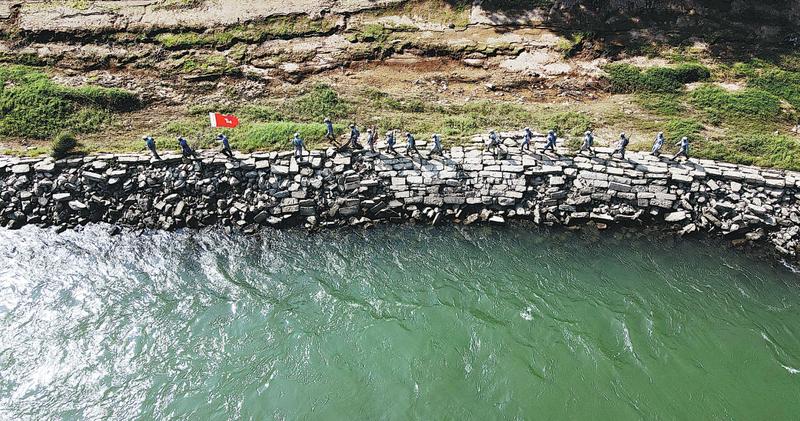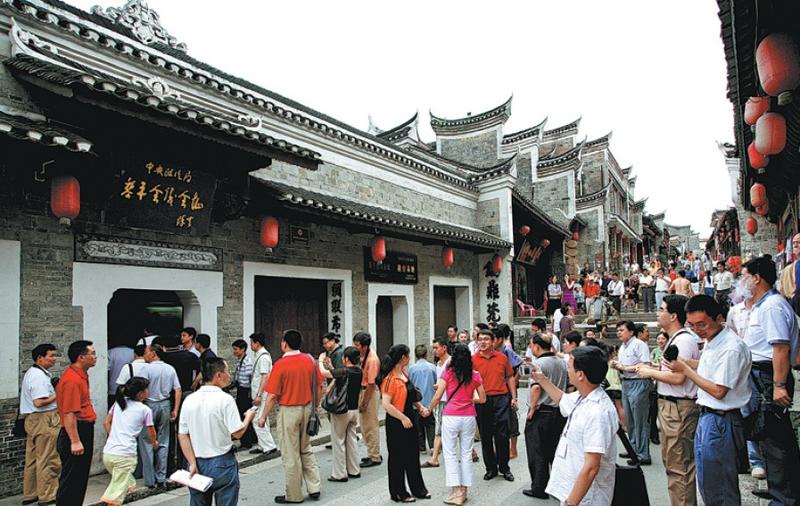Visitors are flocking to sites, such as the venue of the Zunyi Conference, to get a taste of life in the Red Army
 An aerial photo shows a group of tourists replicating the Red Army's famous maneuver to cross the Chishui River in Xishui county, Guizhou province, during the Long March (1934-36). (LUO XINGHAN / FOR CHINA DAILY)
An aerial photo shows a group of tourists replicating the Red Army's famous maneuver to cross the Chishui River in Xishui county, Guizhou province, during the Long March (1934-36). (LUO XINGHAN / FOR CHINA DAILY)
"Cold and cheerless" were the first words that came to local residents' minds when asked about Banqiao, a mountainous town in Loushanguan, Zunyi, in the southwestern province of Guizhou.
"Whenever we opened the window, we saw the mountains. Decades ago, there were only seniors and children because all the young adults had left the poverty-stricken mountains to make a better living outside," said local resident Zhang Yongfeng.
Now, though, Red tourism is warming the small town as countless tourists flock there throughout the year. With visitor numbers rising, Zhang and her husband have chosen to stay in the town and turn to agritainment, earning more than 40,000 yuan (US$6,270) per month during peak season.
The rags-to-riches transformation is part of Guizhou's broader efforts to develop Red tourism to shake off poverty and develop new growth engines.
As an important site during the Long March (1934-36), Guizhou was where the Red Army, a predecessor of the People's Liberation Army, recuperated and went from setbacks to victory. From September 1934 to April 1936, it trekked across more than 60 cities, counties and districts in Guizhou, leaving behind a rich trail of history.
In addition to Guizhou's beautiful scenery and ethnic culture, the provincial government is striving to build it into a leading Red tourism venue. During the recent May Day holiday, Guizhou's Red sites received 34.12 million visits, and, as the Communist Party of China prepares to mark its 100th anniversary, such tourism is expected to further take off.
Cultural park planned
In 2019, the government announced plans to build a national cultural park covering the route of the Long March in memory of the maneuver carried out by the Red Army and led by the CPC against the ruling Kuomintang regime.
The park will spread across 15 provinces and regions, including Guizhou, Fujian, Jiangxi and Gansu. "The development of a national cultural park will embody the 'Long March spirit' and help people learn things when they relax in the park," said Jiang Jiannong, a professor at South China Normal University in Guangzhou, Guangdong province, and an expert on CPC history. He added that the park could tap great potential in the Red tourism sector.
Guizhou has many sites where Red Army soldiers conducted early revolutionary activities. Of the 88 counties, cities and districts in the province, 68 boast Red tourism resources.
 Tourists wait to enter the site of the Liping Conference in Liping county, Guizhou. (FENG JIAXING / FOR CHINA DAILY)
Tourists wait to enter the site of the Liping Conference in Liping county, Guizhou. (FENG JIAXING / FOR CHINA DAILY)
Construction of the park will see Guizhou link Red relics and build classic Red scenic spots and tourism routes.
In particular, Zunyi is one of the most important places, as Mao Zedong reasserted his leadership of the Party at the Zunyi Conference in January 1935. The CPC left the city shortly after the meeting ended.
On February 20 that year, the Red Army crossed the Chishui River for the second time, returned to Guizhou, won the Battle of Loushanguan and retook Zunyi from KMT troops, defeating the enemy's two divisions and eight regiments.
It was the CPC's biggest victory since the start of the Long March.
In recent years, Zunyi has been promoting the sites and relics the Red Army left as high-quality tourist attractions. As the most popular Red tourism spot, the conference site has received more than 4 million visits, according to the local tourism bureau.
In addition to the reconstruction of sites and relics, Zunyi is also promoting the integration of tourism and other industries, including a number of works for film and television that focus on revolutionary history during the Long March.
"The city has scrambled to dig deep into local Red cultural resources to promote the transformation and upgrading of Red tourism to gear up new economic drivers," said Cheng Xiaoqiu, head of the Zunyi bureau of culture, sport and tourism. He noted that the city is also using technology to make Red tours more immersive and interesting. For example, augmented and virtual reality have been introduced to help visitors better understand history through simulated experiences.
The development has totally changed the established tourism model that relies on tour guides for sightseeing and narratives, Cheng said. He added that visitors can also experience immersive activities such as wearing replica army uniforms, laying flowers at memorial parks for martyrs and eating simple meals similar to those given to the soldiers decades ago.
To enhance such experiences, cultural and tourism authorities from Guizhou have launched 10 Red tourism routes centered on the cultural heritage of the Long March and invited tourists to revisit the route, including cycling tours to Liupanshui and a cultural tour of Qiandongnan Miao and Dong autonomous prefecture.
Liping county, another important venue, has rebuilt a large number of cultural relics and historical sites from the Long March era and combined them with the local Dong ethnic culture to develop Red tourism.
On Dec 18, 1934, the Political Bureau of the Communist Party of China Central Committee held a conference in Liping that adopted Mao's ideas.
Their original plan of going north to Xiangxi to join two other Red Army divisions was abandoned, and they established a new base on Guizhou's border with Sichuan province.
This enabled the Red Army to avoid the danger of being encircled by the enemy and paved the way for the Zunyi Conference.
Poverty alleviation
After visiting Liping's Red tourism spots, visitors can visit a nearby tea park, where they can pick tea leaves, taste the beverage and enjoy the dances and music of the local Dong culture.
Yang Zuhua, an executive at the Liping Conference Memorial Hall, said Liping is trying to make full use of Red tourism to allow the proposed national cultural park to have "skeleton, flesh and blood".
In an article he wrote for China Daily this year, Liu Jianping, a professor of Red tourism at Xiangtan University in Hunan province, said such tourism has greatly boosted economy and helped to alleviate poverty and it will facilitate rural revitalization in the central and western regions.
"To boost Red tourism, the government built 2,442 km of roads from 2017 to 2020 to connect revolutionary sites, with more than 90 percent of those roads in Central and Western China," Liu said.
"Just as the War of Independence is an integral part of the United States' history, the Long March is a glorious chapter in China's revolutionary history. But it is necessary to stay true to the fundamental purpose of highlighting the importance of revolutionary sites and refrain from excessive commercialization or spreading inaccurate information to please tourists."
Contact the writers at chengyu@chinadaily.com.cn


